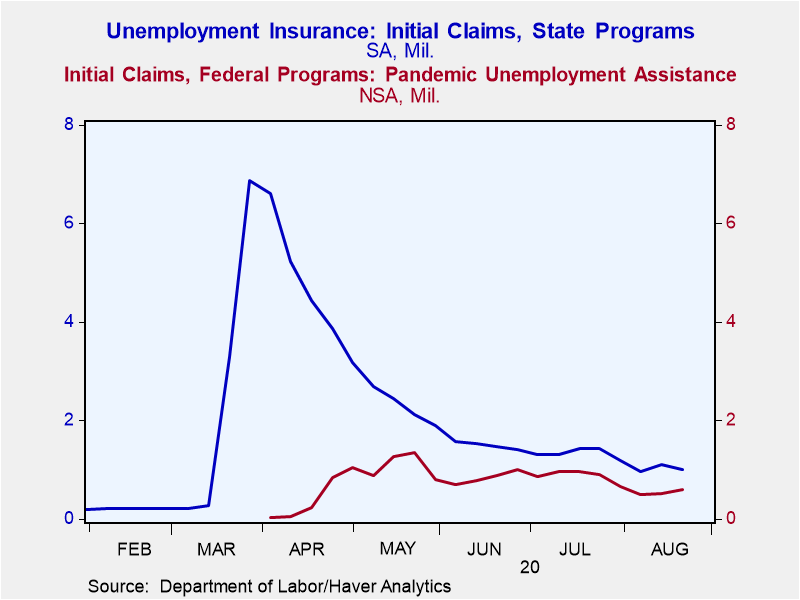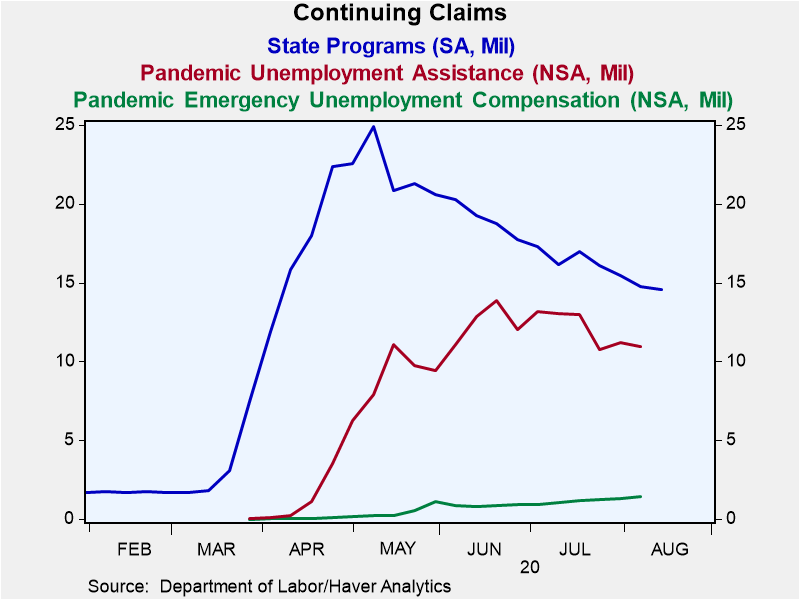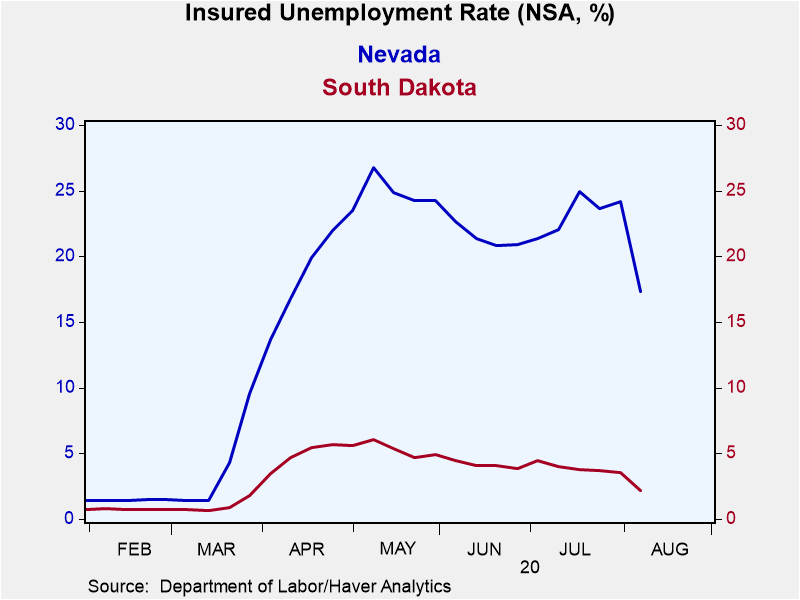 Global| Aug 27 2020
Global| Aug 27 2020U.S. State Initial Claims Remain Over 1 Million
Summary
• State initial jobless claims declined to 1.006 million in the week ending August 22. • Federal Pandemic Unemployment Assistance new filers increased to 607,806, the second consecutive gain. • Continuing claims for state programs [...]
• State initial jobless claims declined to 1.006 million in the week ending August 22.
• Federal Pandemic Unemployment Assistance new filers increased to 607,806, the second consecutive gain.
• Continuing claims for state programs down to 14.5 million; PUA decreases to 11.0 million.
• Fourteen states had insured unemployment rates above 10%. First time since April 11 with no state over 20%.
State initial jobless claims for unemployment insurance declined to 1.006 million in the week ending August 22 from a slightly downwardly-revised 1.104 million (was 1.106 million). The Action Economics Forecast Survey anticipated 1.040 million new state claims. The four-week moving average of initial claims, which smooths out week-to-week volatility, but is less important at the moment because of changing conditions, declined to 1.068 million from 1.175 million.
Claims for the federal Pandemic Unemployment Assistance (PUA) program, which covers individuals such as the self-employed who are not qualified for regular/state unemployment insurance, increased for the second consecutive week to 607,806 from a downwardly-revised 524,986 (was 542,797). Numbers for this and other federal programs are not seasonally adjusted.
Continuing claims for unemployment insurance decreased to 14.535 million in the week ending August 15, from a downwardly-revised 14.758 million (was 14.844 million). Continuing PUA claims, which are lagged an additional week, declined to 10.973 million from an unrevised 11.225 million. Pandemic Emergency Unemployment Compensation claims continued its upward climb rising to 1.408 million in the week ending August 8. This program covers people who were unemployed before COVID but exhausted their state benefits and are now eligible to receive an additional 13 weeks of unemployment insurance, up to a total of 39 weeks.
The insured rate of unemployment declined to 9.9% in the week ending August 15 from 10.1% (was 10.2%); the first reading below 10% since early April. This data does not include the federal pandemic assistance programs. If you include the latest data available, which is lagged one additional week, the number of continuing claims was unchanged at 26.9 million or 16.8% of the labor force.
The state insured rates of unemployment -- which do not include federal programs -- continued to show wide variation with South Dakota at just 2.1% and Hawaii at 19.8%. This is the first time since April 11 that no state was over 20% (Nevada was under 20% for the first time in 16 weeks). The largest states ranged between 5.9% for Florida and 16.1% for California. The state rates are not seasonally adjusted.
Data on weekly unemployment claims going back to 1967 are contained in Haver's WEEKLY database, and they are summarized monthly in USECON. Data for individual states are in REGIONW. The expectations figure is from the Action Economics Forecast Survey, carried in the AS1REPNA database.
| Unemployment Insurance (SA, 000s) | 08/22/20 | 08/15/20 | 08/08/20 | Y/Y % | 2019 | 2018 | 2017 |
|---|---|---|---|---|---|---|---|
| Initial Claims | 1,006 | 1,104 | 971 | 368 | 218 | 221 | 244 |
| 4-week Average | 1,068 | 1,175 | 1,255 | -- | -- | -- | -- |
| Initial Claims Pandemic Unemployment Assistance (NSA) | 608 | 525 | 490 | -- | -- | -- | -- |
| Continuing Claims | -- | 14,535 | 14,758 | 756 | 1,701 | 1,756 | 1,961 |
| 4-week Average | -- | 15,216 | 15,820 | -- | -- | -- | -- |
| Continuing Claims Pandemic Unemployment Assistance (NSA) | -- | -- | 10,973 | -- | -- | -- | -- |
| Insured Unemployment Rate (%) | -- | 9.9 | 10.1 |
1.2 |
1.2 | 1.2 | 1.4 |
Gerald D. Cohen
AuthorMore in Author Profile »Gerald Cohen provides strategic vision and leadership of the translational economic research and policy initiatives at the Kenan Institute of Private Enterprise.
He has worked in both the public and private sectors focusing on the intersection between financial markets and economic fundamentals. He was a Senior Economist at Haver Analytics from January 2019 to February 2021. During the Obama Administration Gerald was Deputy Assistant Secretary for Macroeconomic Analysis at the U.S. Department of Treasury where he helped formulate and evaluate the impact of policy proposals on the U.S. economy. Prior to Treasury, he co-managed a global macro fund at Ziff Brothers Investments.
Gerald holds a bachelor’s of science from the Massachusetts Institute of Technology and a Ph.D. in Economics from Harvard University and is a contributing author to 30-Second Money as well as a co-author of Political Cycles and the Macroeconomy.









